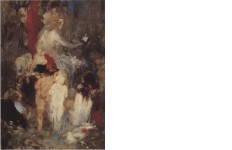TITΛΟΣ ΕΡΓΟΥΑΝΟΙΞΗ
ΔΙΑΣΤΑΣΕΙΣ ΕΡΓΟΥΎψος : 33
Πλάτος : 22.5
ΥΛΙΚΟ ΚΑΤΑΣΚΕΥΗΣΕλαιογραφία (Λάδι σε ξύλο)
ΥΠΟΓΡΑΦΗ ΚΑΛΛΙΤΕΧΝΗΚάτω Δεξιά
ΧΡΟΝΟΛΟΓΗΣΗ
ΕΛΕΓΧΟΣ ΓΝΗΣΙΟΤΗΤΑΣΔεν έχει ελεγχθεί

Provenance:
According to an inscription on the reverse handwritten by Pauline Kurzbauer the work was given by Gysis to Mr Kurzbauer;
Private collection, Athens
Literature:
Nelli Missirli, Gysis, Adam editions, Athens 1996, p. 229 (illustrated), no 176
"Throughout my life I dreamed"
N. Gysis
Imbued with grace, harmony and musical quality, this engaging painting was given by Gysis to Eduard Kurzbauer, an established German artist and his close friend, as verified by Kurzbauers wife on the reverse. In a vaguely defined, imaginary setting, the personification of eternal Spring daintily strews flowers, while at her feet her retinue of putti share in the idyllic atmosphere, forming a pyramid-like compositional structure. The generalised rendering, diffused outlines and unexpected patches of brilliant colour, such as the transparent blues, animated reds and flickering whites, build up a vibrant composition that brims over with a joyful mood. Colour was as critical for Gysis design as light was for ancient Greek sculpture. It imbued his design with an instantaneous, fleeting, yet vibrant feel.1 The vague space, suggestive of a verdant arcadia that opens up to a distant sky, accentuates the idealistic quality of the scene as it enfolds Spring and her young attendants, reminiscent of the children that even when not in a leading role are almost always present in Gysis populous compositions.2
Full of the joy of life, Spring is akin to the visionary renderings of the 19th century idealist painters Puvis de Chavannes, Anselm Feuerbach and Arnold Böcklin who envisioned an imaginary world where all dreams and aspirations could be fulfilled. Charged with spiritual content, this sensitive work marks a nuanced shift from the visible to the invisible and lures the viewer to a transitory state where gravity is negated and the soul elevated to the world of spirits where Music, Art and Love personified abide. The sparkling spirituality stemming from his broadmindedness and ability to engage in discourse with the world underscores Gysis dynamic outlook.3
In her monograph on the artist, N. Misirli notes: Gysis, a visionary by nature, was distinguished by an idealistic outlook on life, which was evident throughout his oeuvre and especially in his allegorical compositions, which were further fuelled by the idealistic and symbolist trends already introduced in the second half of the 19th century. His idealistic output receives fresh impetus following his first trip to Greece.4 (This trip, his first after seven years in Germany, was made in 1872 and was a life-changing experience for Gysis.) For Gysis, life had two aspects. The one the artist observed and perceived with his senses, such as daily events and lifes various episodes, and, at the same time, the one he envisioned, the intangible, eternal aspect that only a few sensitive souls can detect.5
1T. Tsatsos, About Painting [in Greek], Estia publ., Athens 1970, p. 48
2A. Kouria, The Child in Modern Greek Art 1833-1922 [in Greek], Dodoni publ., Athens-Ioannina 1985, p. 39
3S. Lydakis, History of Neohellenic Painting (16th to 20th c.), vol. 3 [in Greek], Melissa publ., Athens 1976, p.168
4N. Misirli, Gysis [in Greek], Adam ed., Athens 1996, p. 212
5C. Lazos, Nicholaos Gysis, Istoria magazine, no. 76, October 1974, p. 104